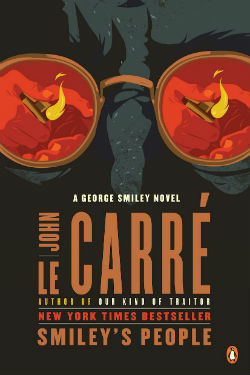 After Tinker Tailor Soldier Spy (1974), John LeCarré had secured his nook within literature as a leading master of the espionage genre. Then, like a ballplayer who knows he can drive one more homer out of the park, he brought his greatest creation, George Smiley, out of retirement once again with Smiley’s People (1979).
After Tinker Tailor Soldier Spy (1974), John LeCarré had secured his nook within literature as a leading master of the espionage genre. Then, like a ballplayer who knows he can drive one more homer out of the park, he brought his greatest creation, George Smiley, out of retirement once again with Smiley’s People (1979).
Oliver Lacon of the Cabinet Office should go easy on Smiley, after all it was Smiley who unearthed the mole in Tinker Tailor and then reestablished The Circus as a viable spy organization in The Honourable Schoolboy (1977) when it was in danger of being defunded. However, when General Vladimir, formerly of the Soviet Union and spy for the Brits, is murdered following a cryptic message that he has some vital information, Lacon pressures the retired agent—since Vladimir had been one of his contacts in the old days—to clean up the spilled milk and put it back in the bottle where it belongs.
Lacon and his bureaucratic peers have little use for the general’s intel aside from putting it to rest quietly then maintain the idea that he was an old fool trying to relive a glorious past. As Lacon warns, the events surrounding Vladimir’s murder could stir an unnecessary risk to the organization, particularly at this stage of its rebirth. Lacon stipulates, clearly aware of who he is addressing, not to go nosing around for additional information … just make sure all loose ends are neatly tied up.
Fat chance. When Smiley learns General Vladimir had fresh data on Smiley’s arch rival, Karla, that’s the one loose thread he can’t help but tug free. A nemesis (whose full, how-do-they-get-that-on-a-plaque title is Chief of the Thirteenth Directorate within Soviet Intelligence) stretching far back in Smiley’s career, Karla had crippled The Circus by placing a mole at the very top of the organization, ultimately discrediting Smiley and his mentor, Control. After all these years though, Karla has gotten sloppy and Smiley begins using Karla’s missteps, as well as a few of his enemy’s strategies, to his advantage. LeCarré writes that Smiley felt, “the drum-beat of his own past, summoning him to one last effort to externalise and resolve the conflict he had lived by.” Ultimately, he wedges Karla between the choice of defecting to the West or accepting his fate at the hands of the unsympathetic Russians.
It’s true that there’s a sense of familiar waters being treaded here—that LeCarré is capitalizing on well-worn triumphs—but Smiley’s People should be heralded as none less than a crowning achievement in the series, bringing the constant warrior to the natural conclusion of his career through the capture of his greatest adversary. If the book is a bit plodding in its approach (The NY Times original review harshly labeled it “a little tired, and the whole book a little bland), then the ending where Karla and Smiley meet near a bridge separating East and West Berlin is as climatic as George Smiley devotees deserve. No satisfying finish for Smiley, though, as he senses that, “an unholy vertigo seized him as the very evil he had fought against seemed to reach out and possess him.”
Ian Fleming's James Bond arrived on the scene a full decade before the first George Smiley novel, and in opposition to that popular mythology and other similar flights of fancy that glamorize spies, LeCarré created the bug-eyed, weary protagonist. If the public most desires Bond (which box office returns seem to support) as the top spy of choice with all his cool swagger and drunken excesses, then George Smiley is the spy they deserve when the hangover arrives: a sober, plump, disheveled public servant who realizes just why history repeats itself.
Walking a short way back along the embankment, almost to where the cross stood, Smiley took another look at the bridge, as if to establish whether anything had changed, but clearly it had not, and though the wind appeared a little stronger, the snow was still swirling in all directions.
Edward A. Grainger aka David Cranmer is the editor/publisher of theBEAT to a PULP webzine and books and the recent Western novella, Hell Town Shootout.
Read all of Edward A. Grainger's posts for Criminal Element.
